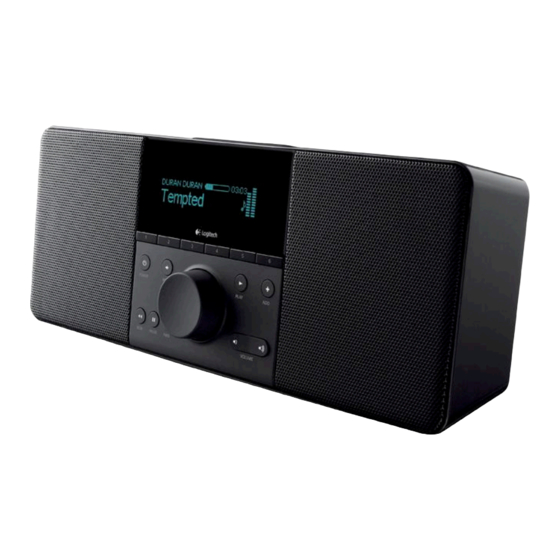
Logitech Squeezebox Instructions Manual
Audio design
Hide thumbs
Also See for Squeezebox:
- Quick start manual (172 pages) ,
- Owner's manual (92 pages) ,
- Features manual (31 pages)
Advertisement
Quick Links
Logitech Squeezebox Boom
Audio Design
Caleb Crome
Sr. Hardware Engineer
Logitech, Inc.
Introduction
Ever since I bought my first Squeezebox from Slim Devices several years ago, I wanted a
version with built-in speakers. I was not alone. Members of the extremely active Squeezebox
community have built quite a few homebrew Squeezebox "boom boxes" over the years,
mashing together Squeezebox hardware with amplifiers, speakers and power supplies from a
variety of sources. After Logitech acquired Slim Devices and I was hired on, I was excited to be
part of the team that would build the Logitech® Squeezebox™ Boom all-in-one network music
player.
Over the past months, our team has worked extremely hard to build a compact, self-contained,
high-performance network audio system. With advanced digital signal processing, a high-quality
bi-amplified speaker design, an easy-to-use user interface, line input and subwoofer output,
Squeezebox Boom is a system that can go in any room of the house and sound great.
After a quick tour of the high-level architecture and disassembly photos of the Squeezebox
Boom, this paper will describe the audio architecture starting from a digital PCM signal (after
any MP3, OGG, FLAC or other decoding), and will follow the signal through the digital signal
processing (DSP) chain, digital-to-analog converters (DACs), power amplifiers, the speaker
drivers and acoustical enclosure.
The DSP signal flow in Squeezebox Boom contains several processing stages that optimize the
sonic experience. The primary DSP stages that will be discussed are: volume processing, bass
management, StereoXL™ stereo enhancement, woofer-tweeter crossover, subwoofer
processing, and driver protection.
1
©2008 Logitech
Squeezebox Boom Audio Design
Advertisement

Summary of Contents for Logitech Squeezebox
- Page 1 Squeezebox hardware with amplifiers, speakers and power supplies from a variety of sources. After Logitech acquired Slim Devices and I was hired on, I was excited to be part of the team that would build the Logitech® Squeezebox™ Boom all-in-one network music player.
-
Page 2: System Overview
P/:AJ7'8/L >Q$)CQ6)O:&< Figure 1: Squeezebox Boom Block Diagram. This paper will discuss the audio design, starting at the I2S & I2C interface between the CPU and Audio sections and follow the signal path through to the speakers, line-in and subwoofer-out. - Page 3 Figure 2: Exploded schematic view of Squeezebox Boom assembly Loudspeaker Drivers The drivers we chose were custom developed by Logitech’s audio engineers to produce the best sounding products while maintaining reasonable costs. The woofers are 3” long-throw drivers with woven cloth cone and a rubber surround. They have a flat frequency response of between 100 Hz and 4 kHz.
-
Page 4: Audio Design
Audio Design Squeezebox Boom is a bi-amplified design, using digital crossovers and independent DACs for each speaker, with a second independent crossover for the subwoofer output. The crossovers and equalization are implemented in software on a digital signal processor (DSP). This is the same technology that’s found in high-end studio monitor speakers. - Page 5 Without a subwoofer, the Squeezebox Boom goes from a -3 dB response at 50 Hz (at low volume settings) to about 85 Hz (at high volume settings), all the way to 20 kHz. With the addition of a subwoofer, the entire audio band, from 20 Hz to 20 kHz, is covered.
-
Page 6: Volume Control
C'6D8E)-'>%9? "%2 <9F Figure 8: Block diagram of the Squeezebox Boom DSP flow (with other components for reference) Volume Control Regular DACs implement digital volume control by simply changing the gain of a signal from one sample to the next. Better DACs will detect a zero-crossing of the signal, and apply volume changes there. - Page 7 Figure 9: Click-less volume changes in Squeezebox Boom. This volume ramping profile shows how the volume gently changes from one volume to another. This shows a switch from 0 to 100% volume, but any other volume change follows a similar.
-
Page 8: Bass Extension
Bass Extension To make the Squeezebox Boom sound fantastic at moderate to low listening levels, we need to extend the bass response. A typical bass control is a very different concept from true bass extension. - Page 9 As can be seen from the plot, -3 dB point is about 100 Hz. Squeezebox Boom comes in a very small form factor, so one wouldn’t really expect a much lower cutoff frequency but you sure do want it to go lower.
- Page 10 (simulated in this figure). They are 4 -order Linkwitz-Riley high pass filters. The method we chose for bass extension with Squeezebox Boom is to make the overall low frequency roll-off a 4 -order Linkwitz-Riley filter. The reason for that choice will become clear in the subwoofer section of this paper.
- Page 11 Line-In The Squeezebox Boom has a line-level input that can be put to many uses. Since it goes into the built-in ADCs in the DSP, we can perform virtually any processing on it we want and sent it back out the speakers, or headphone/sub-output.












Need help?
Do you have a question about the Squeezebox and is the answer not in the manual?
Questions and answers